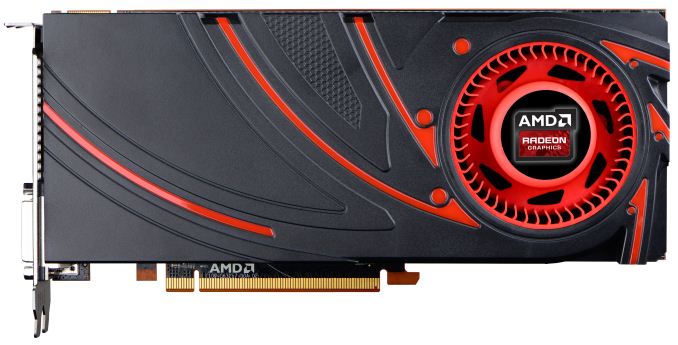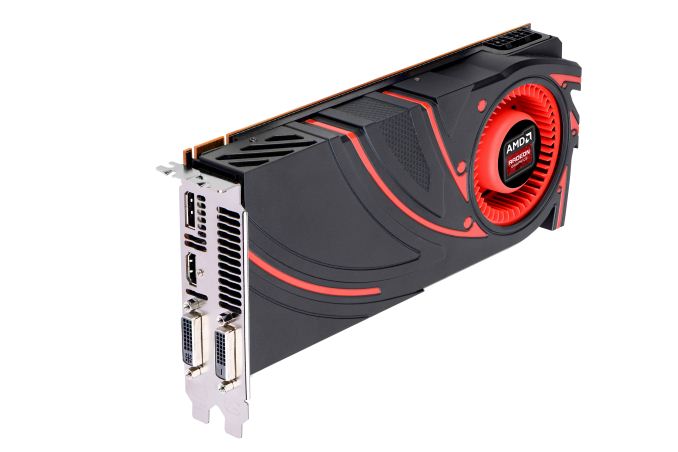The AMD Radeon R9 270X & R9 270 Review: Feat. Asus & HIS
by Ryan Smith on November 13, 2013 12:01 AM ESTMeet The AMD Radeon R9 270X
We’ll start off with our sole 270X card, AMD’s reference Radeon R9 270X. Unfortunately this is one of those cases where the reference card hasn’t been picked up by their partners for their own use, so this card isn’t going to be available at retail. The partners have all gone with their various standard open air cooler designs – honed from the 7870 – which means that a 270X with a blower will unfortunately not be available. The open air coolers do well when it comes to noise, but in this segment it’s nice to have a blower or two available for cramped OEM systems.
In any case, the reference 270X is a very natural evolution of the 7870 that came before it. AMD has kept the same board length of 9.5”, so in terms of functionality and size little has changed. And of course the livery has been done to match the GTX 290 series, featuring the same style shroud and the same fan used to complete AMD’s flagship cards.
Cracking open the reference 270X, we can see that AMD has gone with the same design principles internally too. The 270X is designed like a smaller 290, right down to the metal baseplate providing cooling for various discrete power components and the RAM chips. Meanwhile the heatsink is a scaled down version of the heatsink AMD used on 290, retaining the same general fin structure but forgoing the vapor chamber for a triple copper heatpipe design. Though the placement of the heatpipes strikes us as a bit odd; they’re directly in the channel that air should be going through, and where the 290 had more heatsink instead.
Moving on to I/O, the reference 270X utilizes AMD’s new reference design of 2x DL-DVI-D, 1x HDMI, and 1x DisplayPort. Compared to the 7800 series AMD has dropped the two Mini DisplayPorts for a single full-size DisplayPort, and brought back the second DVI port. Whether partner cards use this implementation or not is largely going to depend on whether partners utilize new board designs; if partners reuse 7800 series board designs, then they’re likely to have 1 DL-DVI port and 2 Mini DisplayPorts, and otherwise it will be AMD’s reference design.
Finally, as a 180W card the 270X has the standard 6-pin + 6-pin PCIe power sockets. It’s only rated for 180W, so this will provide ample power and then-some.













59 Comments
View All Comments
Ryan Smith - Wednesday, November 13, 2013 - link
Non-reference. There isn't a reference 280X, so we're using an XFX card as a proxy.garadante - Wednesday, November 13, 2013 - link
Ah, alright. And I also noticed that there's no overclocking section on this review, which is one of the most important aspects of any GPU review for me personally. Is there a specific reason for that?Erenhardt - Wednesday, November 13, 2013 - link
AMD cards cant be overclocked within "out of the box" policy. Contrary to nvidia cards, which overclocks nicely giving free performance for every CUDA user.garadante - Wednesday, November 13, 2013 - link
I don't know what you're smoking Erenhardt, because AMD cards overclock quite nicely. In fact, overclocking AMD cards is currently much more user open because they can be overvolted, whereas Nvidia has locked down on user overvolting. And I have no clue what "out of the box" policy you're trying to mention. Overclocking an AMD card won't void the warranty unless there's damage to the card itself. Please don't try to troll.ddriver - Wednesday, November 13, 2013 - link
Too bad most nvidia gpus suck in compute...Ryan Smith - Wednesday, November 13, 2013 - link
Solely a matter of timing. I have the data, but this launch happened opposite APU13. So it had to be written very quickly.The 270X topped out at 1150MHz Base (1200MHz boost) and 6.5GHz memory. The HIS 270 topped out at 1075MHz base (1100MHz boost) and 6GHz memory. The Asus topped out at 1125MHz (1150MHz boost) and 6GHz memory.
garadante - Wednesday, November 13, 2013 - link
Ah, alright. Thanks Ryan! So unless it's a fluke, the 270X might be slightly better binned than the 270. Are the default BIOS still not allowing for overvolting like most of the 290 series? Or because these are refreshes, is overvolting already possible with current tools without updates?blanarahul - Wednesday, November 13, 2013 - link
How can the GTX 760 beat the R9 280X in Hitman: Absolution?!The Von Matrices - Wednesday, November 13, 2013 - link
It was said in previous articles (but it should be included in all articles that have the 280X in the chart) that there is no reference 280X card or heat sink so the results they are using are from an XFX card with custom PCB and cooling (but stock clock speeds).laskdfjoiewjfalsd - Wednesday, November 13, 2013 - link
For the love of God post the Nexus 5 review already. I come here everyday and see random stuff like this while a flagship is being put off to the side!